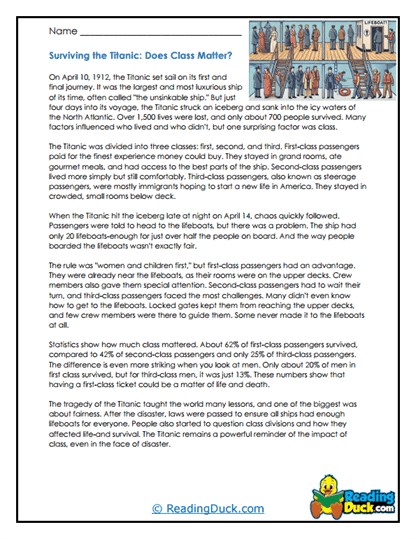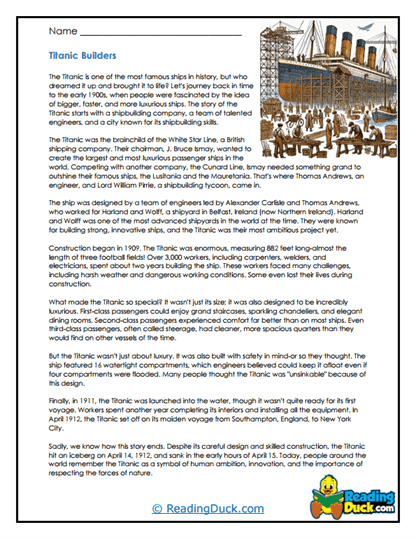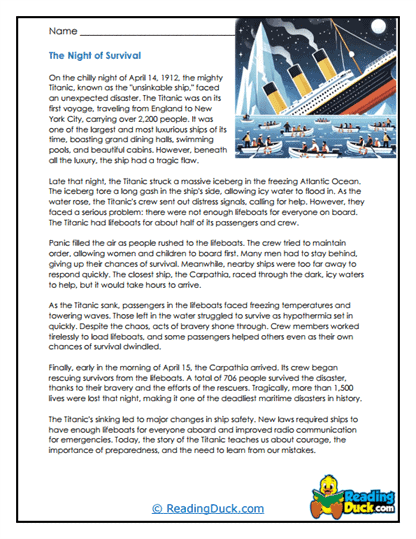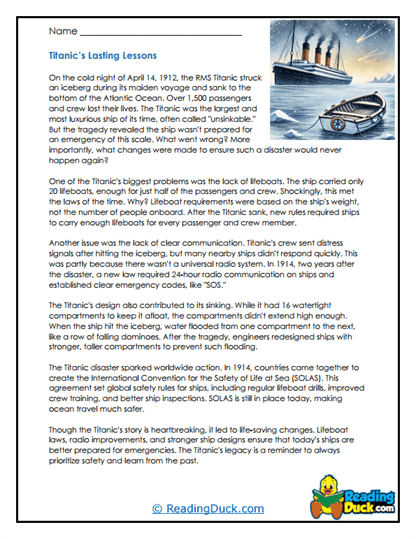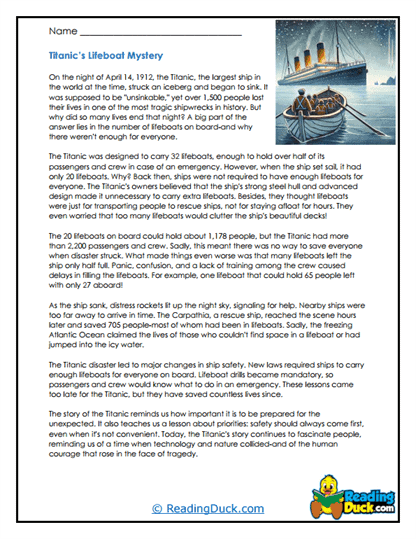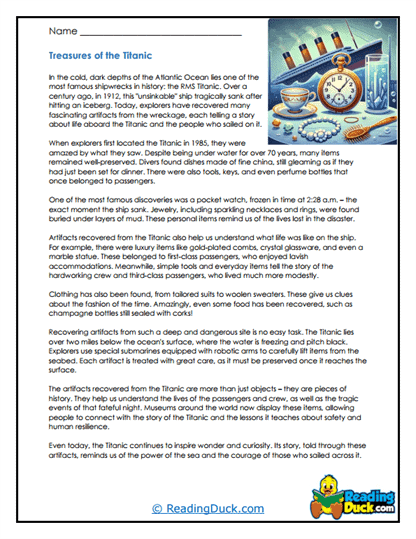The Titanic Worksheets
About Our Titanic Worksheets
These worksheets are great for introducing students to one of history’s most significant maritime events: the story of the Titanic. These worksheets are designed to spark curiosity and foster critical thinking about the tragic voyage of the luxury passenger liner, the circumstances of its sinking, and the profound aftermath. By providing structured, age-appropriate reading exercises, these resources help students explore key facts, historical context, and human stories tied to the Titanic disaster while improving their reading comprehension and analytical skills.
Each worksheet typically includes passages that highlight important aspects of the Titanic's history. Topics may range from its construction and grand design as a symbol of early 20th-century progress to the details of its ill-fated maiden voyage in April 1912. Students learn about the ship’s luxurious amenities, the technology used at the time, and the assumptions surrounding its perceived "unsinkable" nature. These worksheets ensure that the material is engaging by breaking down complex historical events into manageable sections, making the story accessible to various grade levels.
Beyond recounting the tragic night of the sinking, Titanic worksheets often encourage students to examine the human element of the disaster. They can include survivor stories, accounts from crew members and passengers, and reflections on how the event was experienced differently by individuals in first, second, and third classes. Such narratives not only enrich the reading experience but also offer opportunities for students to practice empathy and understand social dynamics during that time period. Comprehension questions following these passages challenge students to identify main ideas, analyze cause and effect, and interpret emotions conveyed in the stories.
Teachers and homeschoolers will appreciate that Titanic worksheets can extend learning beyond simple reading exercises. For example, some worksheets incorporate vocabulary-building activities using historical terms like “iceberg,” “lifeboat,” and “distress signal.” Others might include writing prompts, encouraging students to craft diary entries or newspaper articles as if they were eyewitnesses. Additionally, worksheets may provide thought-provoking questions about the aftermath of the tragedy, such as lessons learned from the event and its impact on maritime safety regulations. These exercises promote cross-curricular connections by integrating reading with writing, history, and critical thinking.
For educators seeking to adapt lessons to meet different student needs, Titanic worksheets offer flexible formats. They can be used for individual study, small group work, or whole-class activities. Homeschooling parents can integrate these worksheets into larger units on historical events, technological advancements, or literature (such as a tie-in with The Unsinkable Wreck of the R.M.S. Titanic or A Night to Remember). The worksheets cater to a variety of learning styles, as students engage with text, visuals like diagrams of the ship, and activities that require higher-order thinking.
Incorporating these worksheets into a curriculum provides students with a window into a real-life historical event that continues to captivate the public imagination. By learning about the Titanic—from its design and voyage to the disaster’s aftermath—students not only develop reading and comprehension skills but also gain a deeper understanding of history, human ingenuity, and resilience. These worksheets equip educators with a powerful tool to inspire thoughtful discussions, foster curiosity, and create meaningful connections between history and literacy.
The Story of the Titanic
The story of the Titanic is one of ambition, tragedy, and human resilience. The RMS Titanic, celebrated as the "unsinkable" ship, set sail on its maiden voyage on April 10, 1912, from Southampton, England, to New York City. This massive luxury liner, operated by the White Star Line, was the epitome of technological advancement and opulence for its time, boasting lavish interiors and state-of-the-art engineering. Carrying over 2,200 passengers and crew members, the ship was divided sharply by class — with first-class accommodations showcasing grandeur, while third-class provided basic amenities for immigrants seeking new opportunities in America. Many aboard believed they were traveling on a vessel that represented the pinnacle of safety and progress.
However, the ship's journey would be cut tragically short. On the night of April 14, 1912, the Titanic struck an iceberg in the North Atlantic Ocean. Despite warnings of icebergs from other ships, the vessel maintained its high speed of approximately 22 knots, prioritizing its scheduled arrival in New York. The iceberg tore into the ship's hull, damaging several watertight compartments and sealing its fate. Panic ensued as it became clear that the Titanic was doomed. The ship lacked enough lifeboats to accommodate all its passengers — a consequence of safety regulations that underestimated the possibility of such disasters. By the early hours of April 15, the Titanic broke apart and sank, claiming the lives of more than 1,500 people.
The aftermath of the disaster sent shockwaves around the world. Survivors were rescued hours later by the RMS Carpathia, which responded to the Titanic's distress calls. Stories of heroism and tragedy emerged, such as accounts of crew members working to save others, and wealthy individuals choosing to sacrifice their seats on lifeboats. The disaster revealed stark inequalities as many third-class passengers were trapped below deck with little chance of escape, reflecting deeper societal divisions of the era. Public outcry over the tragedy led to widespread scrutiny of maritime safety and an urgent call for reforms to prevent similar disasters in the future.
The Titanic’s sinking spurred major changes in ship safety regulations. In 1914, the International Convention for the Safety of Life at Sea (SOLAS) was established, mandating sufficient lifeboats for all passengers, regular lifeboat drills, and improved communication systems. Radio operators were required to maintain 24-hour shifts to respond promptly to distress signals. These measures transformed maritime travel, ensuring that future voyages were safer and better prepared for emergencies. The Titanic became not just a cautionary tale, but also a catalyst for progress in passenger safety.
The legacy of the Titanic endures more than a century later, symbolizing both human hubris and resilience. Its story has inspired countless books, films, and explorations, reminding us of the delicate balance between technological achievement and respect for nature's power. The wreckage, discovered in 1985, lies deep in the Atlantic as a solemn memorial to those who perished. The Titanic continues to captivate the world, serving as a poignant lesson on the cost of overconfidence and the enduring human spirit in the face of disaster.

